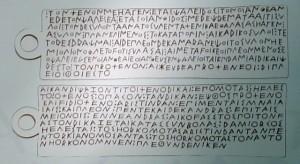Galaxidi In Antiquity
Galaxidi is a blessed place. The variety and agreeableness of the landscape offers natural beauty and other advantages: the hills near the coast provide places for settlement, the small but fertile valleys and the gentle slopes cultivable land, while the surrounding mountain ranges provide protection and ample water. What, though, especially characterizes Galaxidi is its direct connection with the sea. The small, successive bays offer safe harbors, determining already from prehistoric times the fate of this small place.
The oldest traces of settlement date in the Early Helladic I-II Period (3000 B.C.) and are found at four sites: Dexameni or Pelekaris, Kefalari with fortification, the small island of Apsifia, and Anemokambi. The inhabitants, apart from farming and animal husbandry, must have also been seafarers and fishermen. During the late Mycenean Period (1400-1100 B.C.), there existed a settlement at the site of Villa or Goumarnas, and another one at Anemokambi.
At the end of the Geometric Period (around 700 B.C.), the inhabitants took refuge in a hidden, fortified settlement on the hill of Aghios Athanassios, probably because of threats from the sea.
During the Archaic and Classical periods (7th – 4th centuries B.C.), one settlement existed at the site of Villa or Goumarnas, and important archaeological finds have been unearthed at Aghios Vlassis, the religious and administrative center of the City of Chaleion, which is today identified with Galaxidi. Ancient Oiantheia, formerly identified with Galaxidi, was in fact Vitrinitsa. From the 5th century B.C., Chaleion is referred to in ancient Greek literature (Ekataios, Thucydides) as an important city of Western Locris.
Public Life
In the area of Aghios Vlassis, two bronze plates with inscriptions were found in 1848, which ended up in the British Museum. They are dated in the first half of the 5th century B.C. and are extremely important not only for the region, but for the whole of Greek History.
The first one refers to the participation of the Chaleians in the colonization of Southern Italy by the Locrians, and the second one records an agreement between the cities of Chaleion and Oiantheia concerning the protection of navigational rights or, according to another interpretation, the sharing of spoils from piracy. These inscriptions reveal a well developed constitution of the cities in the region, with laws, judicial authorities and specific magistrates.
Much information about this area during the Hellenistic and Roman periods has been drawn from stone inscriptions found in Delphi and elsewhere, which state that Chaleion was one of the two most important cities in Western Locris, second to Amphissa (Amfissa), and that it had a well organized public life with a calendar, religious festivals, magistrates, and a high cultural level. In one of the inscriptions, dated in the 3rd century B.C., a woman poet from Smyrna is honored by the city. Another important document, a 1st century B.C. decree of the Chaleians in honor of the Roman general, Pompeius, is lost today.
Private Life
The Chaleians, like the rest of the ancient Greeks, led a simple life. The majority of them made their living from farming and animal husbandry, and many must have lived off the sea as fishermen or merchants. Their everyday life did not differ a great deal from that of the Greek villagers up until the 1960’s. It began at dawn and ended at dusk. Men lived and worked mainly outdoors, while women stayed at home preparing food, weaving and rearing children.
|
|



